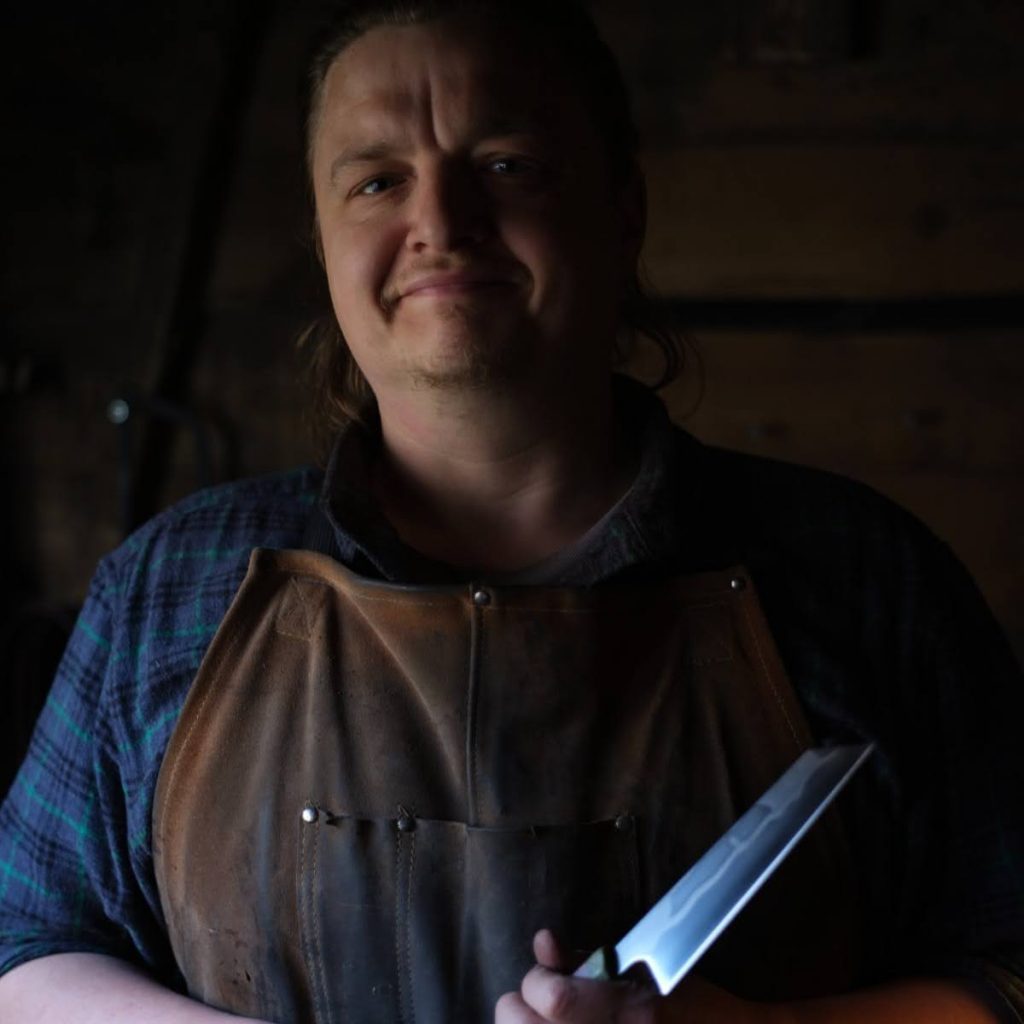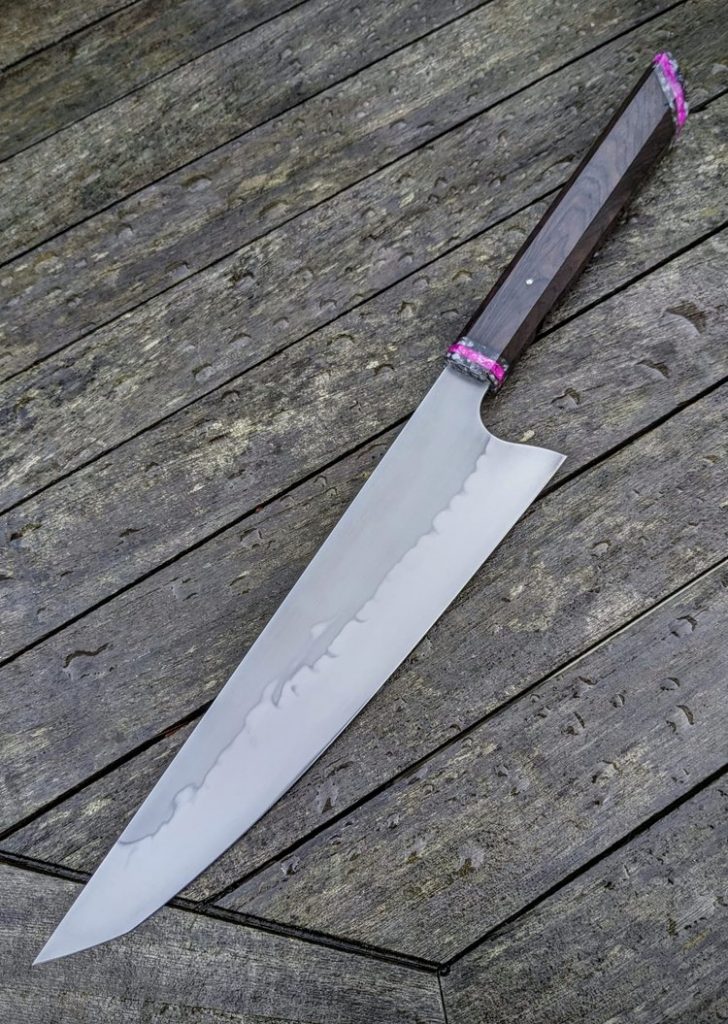
I am very happy to share the story of this knife maker. In many ways I felt like it was a bit reminiscent of my own story. Sometimes when you ask yourself “Why not me?” the best answer is to just put yourself out there and see where it takes you. It has been a pleasure getting to know him, and I am excited to see where he takes his craft.
To start off, please tell us a little about yourself.
My name is Chris Wright, and I’m the maker behind Teddy’s Knives. I discovered my passion for knife making fairly late, at almost forty years old. It’s a world away from my previous jobs. My last role before going full-time with knives was in law enforcement; I was a Detective Constable specialising in child protection.
Part of the reason I left that career was to seek a better work-life balance and be more present for my family. Knife making gave me a way to decompress — it brought order to my life. I find the process incredibly satisfying, with a clear beginning, middle, and end — something that was sorely lacking in the relentless pace of my old job.
Since starting this venture, we’ve added another child to our family (Pearl). My wife, Astrid, has been a powerful driving force — encouraging me and helping me take what was a huge leap of faith from a steady, well-paid job into the unknowns of self-employment.
What sparked your interest in knives?
I was around 12 when my grandad gave me a small scout-style sheath knife. It was Sheffield-made with a leather-stacked handle, and I absolutely loved it.
It rarely left my side when I was in the garden or in the family workshops. Being a child of the 80s, I had no shortage of knife-related influences — from MacGyver and his Swiss Army knife to countless on-screen action heroes. I collected knives for a long time, right up until I started making them.
What inspired you to do this, and how did you learn?
I’d already had a strong interest in knives when Forged in Fire came on TV. I watched it quite a bit. While I found it a bit dramatic at times, I still enjoyed it — and eventually I annoyed myself with my armchair commentary: “He’s messed that up,” or “That tang’s too thin.”
At some point, I said to myself: “If you think you can do better, stop talking about it and give it a go!”
I started learning through trial and error, and from watching a few YouTube videos. In the beginning, I used a homemade forge built from stacked bricks, BBQ coals, and a hairdryer. I’d often be outside waiting for darkness to judge steel colours, doing basic magnet tests and quenching in inappropriate oil (rapeseed!).
Those early knives were rough, and I destroyed many of them with snap tests to check grain growth and destruction tests for edge retention and construction quality.
Slowly but surely, they improved — they held up to abuse, took less edge damage, and eventually became something I was proud to share.

When did you start making knives?
2019.
What did you make your first knife with?
Generic steel from a hardware shop, brass pins, and a bit of oak. Using hand tools and an angle grinder.
Do you have a favorite knife you’ve made? Tell me about it.
My favourite isn’t my most complex or extravagant. I recently made a small full-tang petty with a hamon and bog oak handle.
What stood out for me was the proportions, weight, balance, and the cleanness of the build. I don’t sell anything I’m not proud of — my personal test is how much I want to keep it for myself. And this one? It was the hardest to put up for sale so far.
What is the most important aspect of a well-made knife?
There are so many key factors, but if I had to choose one, I’d say fit and finish.
When I photograph my knives, I do my best to show how well the elements come together. I spend a lot of time on each knife, and I want that attention to detail to be visible. So yes — fit and finish would be my answer.
What keeps you going?
The excitement of turning an idea into a finished piece — or discovering a material I’m eager to work with.
I always want the next knife to be better than the last. Thanks to the income from my experience days, I’m not as reliant on knife sales as I once was. This means I don’t make “filler” knives anymore — every one has to be a “killer” that pushes my abilities. I feel very fortunate to be in that position.

Biggest struggle?
Imposter syndrome. We have so much instant access to the world now, and it’s easy to feel overwhelmed by the sheer talent out there.
As makers, we’re often our own worst critics. Embracing your own style sounds easy, but it’s not always straightforward.
What kinds of knives do you make?
Primarily culinary knives.
How did your background affect your approach to knives?
I’ve got a background in design, and I grew up watching a lot of antique shows and developing an eye for quality.
Whether or not something is to my personal taste, I’ve always had a knack for spotting craftsmanship — the way materials are joined, the finish, and the proportions. I don’t always get it right, but I do think I’ve built a solid understanding of what quality looks like.
Who helped you early on?
Jersey-based maker Nick Le Marquand had a huge impact on me, especially with his work on hamons — that’s what got me hooked.
He gave me loads of advice and always pushed me to do better. He wasn’t afraid to be brutally honest, which only made me improve faster.
Who are your influences?
There are many, but a few key ones are:
Nick Le Marquand
Neil Ayling of Willow Forge
Dean Bruce of Gemini Knives
Mads McClean of Sindre Knives
They all maintain sky-high standards — all killer, no filler — and they inspire me to do the same.
Any specific breakthroughs or revelations in your knife making journey?
Definitely teaching. I’ve discovered a genuine love for spending time with people in my workshop through the experience days.
I’ve had all kinds of people through the door, and somehow, I’ve never had a bad day. Everyone brings something. I’ve learned just as much from my students as they have from me.
What is the perfect knife?
Still trying to work that one out!

How do you approach knife testing?
File tests, snap tests, edge deflection tests. I also cut through various mediums to check for cleanliness of cut and food release.
I spend a lot of time checking the travel from heel to tip. I use an engineer’s flat to refine this and ensure the movement feels smooth and elegant.
How do you develop a design, select a steel, and fine-tune heat treatment?
Designs usually come straight from my head. I rarely measure anything — it’s a very organic process. Every knife is different, though function remains the one constant.
As for heat treating, I don’t claim to be a metallurgist, but I use accurate equipment and high-quality materials. I’ve built a set of tried and tested recipes that deliver the results I want.
What do you like about carbon steels?
I love a patina. There’s a certain romance and mystique in how they age with use.
A knife should be an heirloom — it’s like inheriting a watch. One that’s box-fresh isn’t nearly as special as one that’s worn the marks and scars of a life well-lived.
How has the knife world changed since you started?
It’s always been a bit divisive. I fear knives are becoming more demonised, and it’s on us as makers to be above criticism — to be diligent with age checks and to highlight the positive, artistic, and cultural value of what we do.
We need to push back against the overwhelming negativity in the media.
What’s up next for you? Any exciting new projects?
I love running my experience days, and I plan to continue sharing my passion and meeting amazing people.
That doesn’t mean scaling up, though — I’m not chasing numbers. I prefer small 1-on-1 or 1-on-2 sessions that lets me, and my students get to know each other, share stories, and learn together.
To learn more about Chris’ work and classes. Check out his website http://www.teddysknives.co.uk or his Instagram accounts http://www.instagram.com/teddys_knives or http://www.instagram.com/teddys_experience_days
Leave a Reply